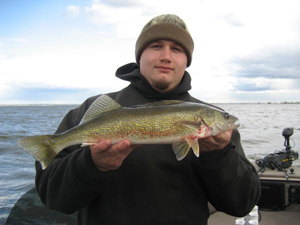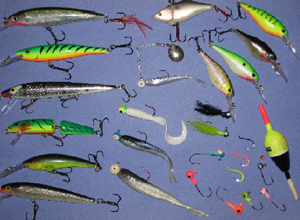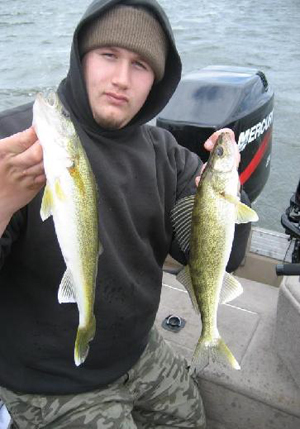 One summer day a few years back I was fishing a southeastern Wisconsin lake for largemouth bass. It was about 85 degrees outside and the sun was beating down hard. My friend and I had the boat positioned over a weed flat that dropped slowly into deeper water. After a few medium sized bass and a few northern pike, I suddenly caught a decent sized walleye. Two more casts later I landed yet another walleye. Pretty soon we were all hyped up on the fact that walleyes were in the area. So we rigged up some slipbobber rigs, used leeches suspended over the weeds, and had fun catching a few more walleyes that day. Often overlooked and misunderstood are the walleyes in the weeds.
One summer day a few years back I was fishing a southeastern Wisconsin lake for largemouth bass. It was about 85 degrees outside and the sun was beating down hard. My friend and I had the boat positioned over a weed flat that dropped slowly into deeper water. After a few medium sized bass and a few northern pike, I suddenly caught a decent sized walleye. Two more casts later I landed yet another walleye. Pretty soon we were all hyped up on the fact that walleyes were in the area. So we rigged up some slipbobber rigs, used leeches suspended over the weeds, and had fun catching a few more walleyes that day. Often overlooked and misunderstood are the walleyes in the weeds.
In lakes that have stocked walleyes, these fish are more known to use weed cover throughout the year. One theory is that these stocked walleyes have spent a small portion of their lives in fish hatchery ponds that are normally grown in with weeds. Therefore, these fish go right for the weeds that they are used to seeing when they were in these hatchery ponds. Weeds provide cover from the sun, cooler water, oxygen, and are filled with aquatic life that the predator fish like walleyes, northern pike, and bass feed on. Walleyes can position themselves in these weeds to set up an ambush on baitfish like perch, bluegills, minnows, shiners, and suckers. It is common practice for anglers to head out on a lake for walleyes and immediately search every sunken island, hump, and rock bar in the lake. After coming back to the boat launch empty handed, or with minimal results, they say the lake is all fished out, and the walleye fishing has gone down the tube. These lakes may be loaded with walleyes, but these walleyes may just be where you least expected.

To begin your search for walleyes in the weeds, there are a few characteristics that will help your search become easier. Search for areas that are easy for the walleyes to access deeper water. Weed flats in 3 to 14 feet of water that slowly drop into deeper water are great places to start. If you can find the weed edges, inside turns of the weeds, and if these weed flats have a mixture of rocks and boulders, you have the ingredients for a great area to scope out for walleyes. Walleyes like these weed flats because they don’t have to move far for shade, cooler water, food, and an escape route into deep water if they feel threatened for any reason or, need to find more comfortable temperatures.
The way you catch these walleyes depends on the activity levels of the fish. When fish are more aggressive and willing to bite, a 3 to 6 inch jerkbait like a Rapala X-Rap, Husky Jerk, Original Floating Rapala Minnow, Jointed Rapala Minnow, a Smithwick Rogue in a suspending or floating model can be deadly options. You can cast and reel these jerkbaits with a slow to moderate steady retrieve. Or you can twitch these jerkbaits to make them look like a wounded baitfish. The baits like the Rapala X-Rap and Husky Jerk are built to suspend so you can pause these baits during your retrieve and fish them extremely slow to tempt inactive fish to bite. Deep diving and lipless crankbaits are another aggressive option for active walleyes. Rapala Minnow Raps, Tail Dancers, Shad Raps, Berkley Flicker Shads, and Rapala Rattlin’ Raps are all hot crankbaits for walleyes. Walleyes respond more to slender lures then the fatter crankbaits you would use for bass fishing. These are magnificent lures to cover a lot of water quickly to search for the active feeding walleyes or, to find where the fish are schooled up together the most. You can reel crankbaits slow, fast, and use a stop and go retrieve. The best crankbaits dive just deep enough to tick the top of the weedbeds. You don’t want them diving down too deep into the weeds because you’ll be spending more time ripping weeds off the hooks then catching walleyes. In water depth 3 to 10 feet a jerkbait is the prime choice to catch walleyes. In water 10 feet and deeper a crankbait will be a great choice. Another overlooked walleye bait is a small spinnerbait like a Beetle Spin. You would be surprised how many fish hit this lure. Fish these lures on 10 to 14 pound test braided fishing line like Power Pro or Berkley FireLine, or 10 to 12 pound test monofilament or fluorocarbon line. A medium action spinning rod or bait casting rod that is 7 feet in length is a suitable setup for fishing jerkbaits, crankbaits, and small spinnerbaits like the Beetle Spin. The length of the rod helps you cast farther, and the extra stiffness helps you drive the hooks into the walleye’s mouth, and pull them up and out of the weeds. A light action or medium/light action rod would be to flimsy to haul these fish out of heavy cover

When walleyes are less active, livebait like minnows, leeches, and nightcrawlers are a great option to tempt these inactive walleyes into biting. A 1/32 to 1/8 ounce jighead tipped with a leech, half a nightcrawler, or a minnow like a fathead, sucker, or shiner is deadly on walleyes anywhere walleyes live. I like to cast these jigs out and slowly twitch or hop them back to the boat. Weedless jigheads with rubber or wire hook guards are also available and are proven deadly. Another option is a slipbobber rig. You can use a plain hook or small 1/32 to 1/16 ounce jighead. Set your bobbers to suspend the bait just over the tops of the weeds. The idea is to present your livebait to swim and look as lively and natural as possible. So the smallest hooks you can get away with and the least weight you can get away with is your best choice. A 7 foot medium/light action graphite spinning rod spooled with 6 to 8 pound test monofilament, or a very thin diameter braided line like 10 pound test Power Pro or Berkley FireLine will work great. The thin diameter of braided lines cuts through water faster helping your jig touch bottom, and the low stretch helps you feel bites a lot better than monofilament line would. In clear lakes, I prefer fluorocarbon or monofilament lines because they are more invisible under water and, walleyes can tend to be line shy. In stained water, braided line will work fine because the fish won’t see the line as well.
Walleyes also use weed beds at night when they are searching for vulnerable baitfish to feed on. The walleyes will move up the drop-offs from deeper water to feast on an easy opportunity. Casting Rapala Original Floaters in 5 to 6 inch models, or Rapala X-Raps, and Husky Jerks over these weed beds and reeling extremely slow can show amazing results. Also, light up slipbobbers with a minnow, leech, or nightcrawler can be very effective.
Whatever way you plan on catching walleyes, try to find out if the lake you are fishing is stocked or has a natural reproduction of walleyes. Stocked walleyes spend a great portion of their lives in the weeds because of the weedy habitat they were around as babies at the fish hatchery. You may be passing up an underrated and great fishing opportunity if you neglect the weeds when you are searching for walleyes. Good luck out on the water and I hope these fishing tips help you put more walleyes in your boat this year.










